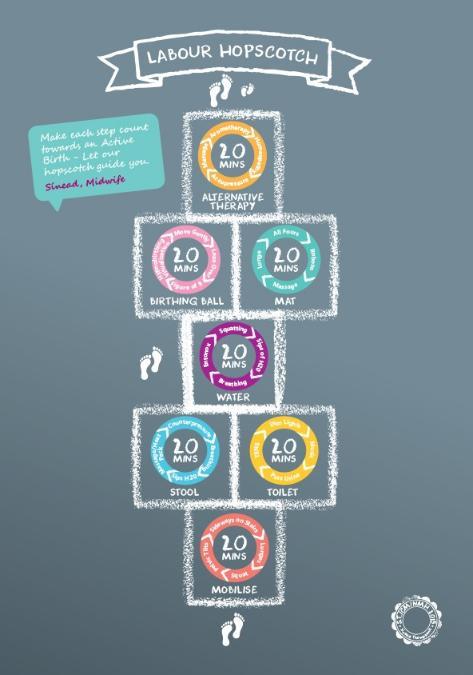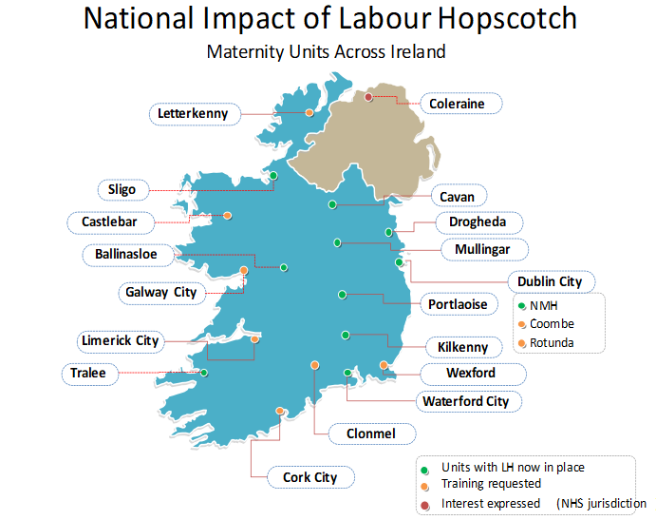Summary
Evidence shows that “physiological” births, powered by the innate abilities of the body, benefit the mother and baby, and reduce the potential harm posed by medical interventions like epidurals and caesarian sections. Despite this, the rates of physiological birth continue to decline in Ireland.
To address this, midwife Sinead Thompson developed the Labour Hopscotch Framework (LHF), which gives women and their partners a series of simple steps to support a physiological birth. A team of researchers at UCD and the National Maternity hospital have now evaluated the LHF, finding that it is an effective tool for promoting shared, inclusive decision-making during childbirth.
On the back of these findings, the LHF has been rolled out nationally by the Department of Health, and it has been included in national standards for antenatal education, empowering women and their birth partners, and improving health outcomes for mother and child.
Research description
 The Labour Hopscotch Framework (LHF) was designed by Sinead Thompson, a Community Midwife at the National Maternity Hospital, in response to growing concerns by senior midwifery management about rising rates of medical intervention during childbirth. At the time, the national rate of caesarean section was 31.2% from a total of 61,655 births. The LHF offers women and their partners a series of practical, 20-minute steps to take to support a so-called “physiological birth”, powered by the innate abilities of the woman and foetus, without resorting to medical interventions like epidurals and caesarean sections.
The Labour Hopscotch Framework (LHF) was designed by Sinead Thompson, a Community Midwife at the National Maternity Hospital, in response to growing concerns by senior midwifery management about rising rates of medical intervention during childbirth. At the time, the national rate of caesarean section was 31.2% from a total of 61,655 births. The LHF offers women and their partners a series of practical, 20-minute steps to take to support a so-called “physiological birth”, powered by the innate abilities of the woman and foetus, without resorting to medical interventions like epidurals and caesarean sections.
When medically necessary, caesarean sections can save the lives of mothers and babies, but they can cause significant complications. Physiological births reduce interventions and improve women's experiences of childbirth, by offering choices such as hydrotherapy, massage, acupuncture, increased physical activity, active birth strategies, and changes in birthing position. Physiological birth is also associated with earlier initiation of breastfeeding.
The LHF is a visual birthing tool, laid out like the childhood game hopscotch. The steps it suggests include things like sitting on a stool while being massaged and keeping mobile by walking sideways on a flight of stairs.
To evaluate the effectiveness of the LHF, a team of researchers from UCD and the National Maternity Hospital conducted a research project based around a survey of 809 women and 759 partners, as well as a focus group of 8 midwives. They studied the experiences that women and their partners had with the LHF, the different factors that lead to women to using it, and the extent to which the LHF influences rates of epidurals.
40% of women reported that the LHF had influenced their decision-making about pain relief during childbirth. The epidural rates were much lower among women who engaged with the LHF (38.5%) compared to the overall hospital epidural rate (57%).
90% of women reported that the steps of the LHF helped them to feel very or somewhat confident to cope with labour. The researchers also found a significant association was found between how physically active a woman is during labour and the mode of birth taken. Of the 641 women who identified this physical activity as being the most beneficial step in the LHF, 78% had a normal birth, while 14% had a forceps or vacuum birth, and just 8.7% had a caesarean section.
Birth partners supported the use of the LHF, with 79% recommending that it should be used by women during childbirth. Midwives also suggested that the LHF inspired women to take initiatives and play an active role in their birthing experience.
As Lead Midwife in the National Women and Infants Programme we endorse this framework and we have seen the benefits and are now rolling it out across the 19 maternity units.
—Angela Dunne, Director of Midwifery, National Women and Infants Health Programme
 Despite strong evidence of how a physiological birth benefits mother the baby, as well as the potential harm posed by unnecessary obstetric intervention, the rates of physiological birth continue to decline in the general population. Responding to this, the LHF was designed as “a midwifery package of care with a philosophy embedded in the inherent normality of childbirth and the natural ability of women to achieve it”.
Despite strong evidence of how a physiological birth benefits mother the baby, as well as the potential harm posed by unnecessary obstetric intervention, the rates of physiological birth continue to decline in the general population. Responding to this, the LHF was designed as “a midwifery package of care with a philosophy embedded in the inherent normality of childbirth and the natural ability of women to achieve it”.